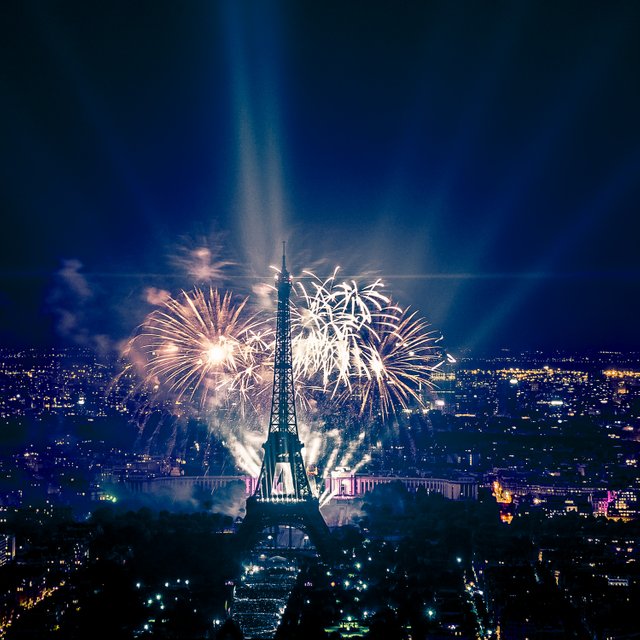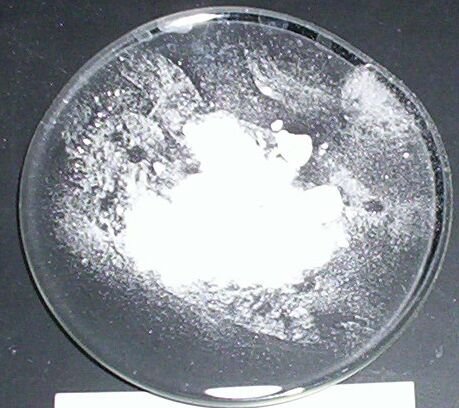The environmental concerns with fireworks
It’s New Year’s Eve tonight, and a lot of cultures celebrate this by shooting fireworks loaded with industrial chemicals into the air in order to create the classic firework shows we all come to expect from this very night. I agree with everyone that it’s very beautiful, but I would like to use this opportunity to highlight one of the negative effects that are tied to this celebration.

Photo by Yann Caradec, posted with the CC BY-SA 2.0.
I will be focusing on the environmental concerns with shooting up fireworks, which can be roughly divided into two groups; the air pollution, and the pollution from the chemicals getting into drinking water. But there are also a lot of other problems with fireworks that I won’t be writing more about in this particular post, including people getting burned trying to shoot them up (accidents leading to problems with the eyes are especially common), houses catching fire from malfunctioning firework, birds dying from shock, animals getting panic attacks, and potential economic problems spending so much money on a ten minute event.
Environmental concerns with fireworks
The basis of my environmental concerns from fireworks is that we need to use a lot of heavy metals and other chemicals that are harmful to life in a certain concentration in order to create them. Or more precise, the heavy metals are used to give the fireworks the different colors. In addition to this, a chemical known as perchlorate is used to launch the fireworks into the air, and this chemical also has some environmental concerns attached to it.

You can see barium chloride in this petri dish; a toxic metal that gives a green color upon combustion, and it's therefore used to create the green fireworks. The image has been released as Public Domain.
We will begin by looking at the air pollution and what research has to say about that, followed by a closer look at perchlorate and how this chemical can lead to health concerns when it ends up in drinking water.
Air pollution from firework
During celebrations where fireworks are launched into the air, air pollution tend to increase a lot. Areas with a higher concentration of firework obviously give a higher concentration of pollutants, but it tend not to get directly harmful for humans. The firework events contribute with a high amount of the annual pollution of some elements such as potassium, aluminum, magnesium, lead, barium, copper, and more (Moreno et al., 2007). These elements are not the ones you typically find in a high concentration up in the air, so we often see that New Year’s Eve, Chinese New Year, or July 4th tend to be where the airborne concentration of some of these heavy metals reach its highest point.
Some researchers have measured concentration of aerosols (the sum of all pollutant particles) to be high enough to be potentially harmful to humans (Zhang et al., 2010; Moreno et al., 2007), but from my understanding healthy people will not have a direct health risk, but those of you with a prior problem with your lungs might want to take it easy with staying too much outside tonight. Measurements from major Norwegian cities have also shown a high concentration of aerosols on the few hours before and after midnight on the night between December 31st and January 1st. Keep in mind that the latter source is not a scientific article, but rather an article from the Norwegian Institute for Air Research. They also say that the air is generally not problematic for healthy people, but anyone with a lung problem should be careful with spending too much time outside.
So I think we can agree that the air pollution in most cities are not that dangerous, but it’s something to keep in mind for those who are already sick with a respiratory disease. It's also more problematic for people who live in crowded cities with a higher concentration of local fireworks.
Perchlorate pollution as a consequence of fireworks
The pollution caused by the perchlorate is a bit more problematic than the air pollution from heavy metals, and the reason for this lies with the fact that the perchlorate is soluble in water. Basically any perchlorate that ends up in the water will be able to stay there for 20 to 80 days before being removed by the sediment via chemical adsorption (Wilkin, Fine & Burnett, 2007). While I haven’t found exactly how little perchlorate that is considered to be dangerous, we’re talking about a chemical that can harm people with a very low concentration, even compared to the heavy metals discussed above. Note that while some of the heavy metals discussed above are considered to be very toxic if mixed to the drinking water, the concentration is too low to really have any effect after being diluted in water.
As briefly mentioned in the introduction, perchlorate is the chemical that is used to propel the fireworks up in the air. When it gets into a human (or I would assume other vertebrate organisms), it can inhibit the sodium-iodide symporter in the thyroid gland. This is a protein that is responsible for transporting sodium ions into the cell, and when it is inhibited it cannot create thyroid hormones (Wolff, 1998).
A 3D rendition of a perchlorate molecule. It's far from the most complex molecule out there, but the negatively loaded ion can do some damage. The image has been released as Public Domain.
The health concerns with perchlorate is mainly for pregnant women, newborns and young children (Wolff, 1998), but studies done on rabbits have shown that it can have a toxic effect to the lungs (Wu et al., 2013) altough no studies have been done on the effects of exposure to perchlorate on human lungs. Grown humans will be able to resume the production of thyroid hormones once the perchlorate is removed from the body, while very young children won’t be able to do this, and can end up with permanent damages from it. So it’s not a super dangerous chemical for grown ups, but it’s potentially a huge problem for young children who get sick from drinking water with this chemical in it. Pregnant women obviously need to drink water, so I can understand why this chemical is a big concern for the agencies who are responsible for the drinking water quality.
The good part about this is that we can reduce the exposure of perchlorate to a certain extent. Unfortunately we don’t have any good alternatives to propel the fireworks into the air just yet (but smart people are working on it), but we can reduce the amount that get into the water by reducing the amount of fireworks shot up from areas in close proximity to drinking water. I don’t even want to know who thought it was a good idea to shoot up fireworks next to a drinking water source, but apparently this is something that happens.
Sources
- Moreno, T., Querol, X., Alastuey, A., Minguillón, M. C., Pey, J., Rodriguez, S., ... & Gibbons, W. (2007). Recreational atmospheric pollution episodes: inhalable metalliferous particles from firework displays. Atmospheric Environment, 41(5), 913-922.
- Wilkin, R. T., Fine, D. D., & Burnett, N. G. (2007). Perchlorate behavior in a municipal lake following fireworks displays. Environmental science & technology, 41(11), 3966-3971.
- Wolff, J. (1998). Perchlorate and the thyroid gland. Pharmacological reviews, 50(1), 89-106.
Wu, F., Chen, H., Zhou, X., Zhang, R., Ding, M., Liu, Q., & Peng, K. L. (2013). Pulmonary fibrosis effect of ammonium perchlorate exposure in rabbit. Archives of environmental & occupational health, 68(3), 161-165. - Zhang, M., Wang, X., Chen, J., Cheng, T., Wang, T., Yang, X., ... & Chen, C. (2010). Physical characterization of aerosol particles during the Chinese New Year’s firework events. Atmospheric Environment, 44(39), 5191-5198.
Thanks for reading
My point with this post was not to ruin your celebration tonight, but rather to enlighten you with the knowledge about the things that are not so good about fireworks, since I have experienced meeting quite a few people that had no idea about these problems. Anyway, stay safe tonight, and please don’t drink a lot of alcohol before you fire up your fireworks! I hope you enjoyed learning a bit more about the environmental problems with the pollution from fireworks, and please let me know what you think of it down below.
While I have been always aware of the negative impacts of the noise and light from fireworks (and thus don´t like them), I have actually never thought about the chemical stuff they are made from. Very interesting and enlightening read as always my friend! Thank you for writing this post for us. Happy New Year to you and your family! :)
I think the environmental effect is a bit less known than the impacts from noise and light, which can both in worst case scenarios be deadly for wild animals. So I'm glad that you learned a new aspect of the effects from fireworks. Happy New Year to you as well!
I'm really glad you write about this. It's something that not that many know of (including me until just now) but indeed when taking into account how much fireworks get shot into the air each year, its a rather significant pollutant. Maybe not a topic for now indeed, but like alcohol it is important to know the aftermath 😉 thanks for this!
Posted using Partiko Android
I'm glad you found it interesting, and even learned something new about fireworks :) Thanks for stopping by, @samve!
Mange takk for ein svært grundig og veldokumentert artikkel om dette emnet @Valth
Eg er imponert over evna di til å setja deg inn i ulike aktuelle tema.
Elles er eg samd meg deg om å feira med måte på nyttårsafta og ta det med ro.
Brukar ikkje sjølv nyttårsrakettar, men tittar på dei gjennom stovevindauga.
Ei roleg nyttårsfeiring i lag med familien heime er ein god skikk for nyttårfeiringa meiner eg.
Eg vil ôg takka for dei mange gode artiklane du har skrive i løpet av det gamle året, og vil nytta høvet til å ynskja deg eit Godt Nytt År!
Hei og takk for en fin kommentar om artikkelen, @siggjo. En rolig nyttårsfeiring med familien høres veldig koselig ut!
Jeg ønsker deg også et riktig godt nytt år, og håper også du fortsetter med å publisere bra innhold her på Steem-blokkjeden! Jeg ser frem til å se hva slags bilder du viser frem i 2019.
Hi @valth!
Your post was upvoted by @steem-ua, new Steem dApp, using UserAuthority for algorithmic post curation!
Your UA account score is currently 5.188 which ranks you at #860 across all Steem accounts.
Your rank has not changed in the last three days.
In our last Algorithmic Curation Round, consisting of 268 contributions, your post is ranked at #126.
Evaluation of your UA score:
Feel free to join our @steem-ua Discord server
This post has been voted on by the SteemSTEM curation team and voting trail in collaboration with @curie.
If you appreciate the work we are doing then consider voting both projects for witness by selecting stem.witness and curie!
For additional information please join us on the SteemSTEM discord and to get to know the rest of the community!
Thanks!